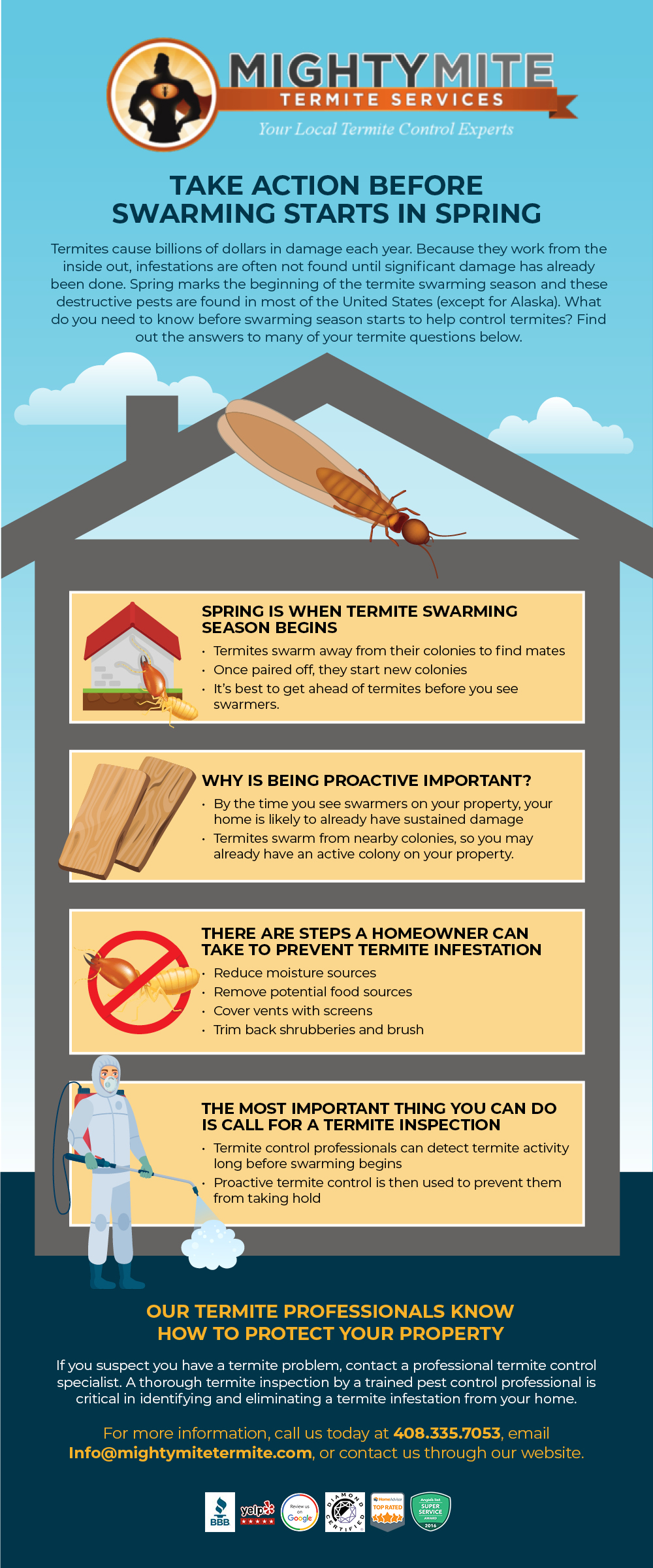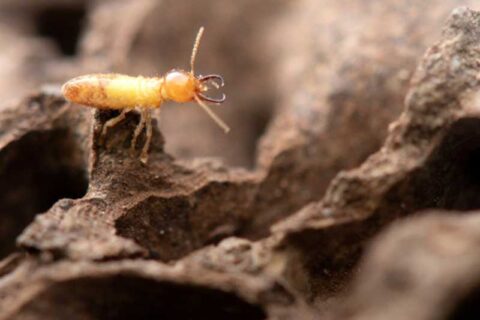Take Action Before Swarming Starts in Spring
Every year, termites cause billions of dollars of damage to homes and other buildings in the United States. These insects don’t hibernate, and if you’ve got an infestation, they’ll continue chewing through your house, no matter the season. In spring, however, you might perceive that there’s increased activity, as you notice these flying insects or see discarded wings in your windowsills. Does this mean you have a new infestation? Here, we explain why termites swarm and why it’s so important for a homeowner to get ahead of the springtime swarming season.
Termites have a complicated, highly structured social system, with a king and queen, workers, soldiers, and alates. Alates are young reproductive termites, and in the spring, they’re ready to begin new lives as kings and queens of new colonies. They’re the only termites with wings, and they use these wings to fly away from their original colonies, seeking mates and new places to live. Once they’ve paired off and found a new home, they drop their wings and start a family, establishing a new colony.
This might sound like a sweet and romantic story, until you remember that these are incredibly destructive creatures whose new families will devour the foundational structure of your home. When you consider that, you’ll understand why it’s important to keep swarmers from building their colonies on your property. What you might not understand, though, is why it’s vital that you take proactive measures even before you see swarmers.
Here’s the reality of the situation: swarmers don’t fly very far. What does that mean? By the time you see swarmers in your house, there’s probably already damage to your home. Because alates swarm from nearby colonies, the presence of flying termites or their wings in your house is typically a sign that a termite colony exists on your property. While termite colonies are relatively small in the first couple of years after an infestation, they can quickly grow to be quite large, sometimes with millions of termites living there, all eating away at your home all year long.
How can a homeowner be proactive about preventing termite infestations? There are certain steps to take and best practices that will discourage them from setting up residence in your home.
- First, reduce moisture sources. Termites live underground and travel to your home in mud tubes because they have to remain moist in order to survive. Removing moisture from your crawl space and reducing moisture around your house, then, will make the environment less appealing for termites. Fix leaky faucets and pipes as quickly as possible, and keep your crawlspace dry. Prevent water from pooling around your foundation by grading your landscape away from the house, maintaining your gutters and downspouts properly, and moving sprinklers so that they don’t spray the foundation.
- Next, address potential food sources. It’s common knowledge that termites eat wood, but not everyone knows that what they’re really seeking is cellulose. Cellulose is found in wood, but it’s also found in other materials that contain plant fibers, including cardboard, sheetrock, and paper. Termites will infest plywood, construction planks, and firewood, and they’re particularly drawn to rotting wood. If you don’t want your home to seem like a termite paradise, avoid storing cardboard and paper in the crawlspace, store your firewood off the ground and away from your house, keep building materials away from your home’s exterior, and remove any stumps or other non-living wood from your property.
- Then, make sure you’re not allowing termites easy access to your home. Keep them out of your ductwork by sealing your vents with wire mesh screens. Seal any cracks or holes in your home’s exterior with caulk, to prevent them from allowing termites to get through and into your house. Don’t allow overgrown brush to stay on your property, and trim any bushes, shrubs, or trees that come into contact with your house. Trim plants around the house back a couple of feet in the spring, to discourage swarmers from taking up residence.
The best thing a homeowner can do to prevent termite infestation, however, is to call in the professionals and have a termite inspection. While some pest control can be handled through DIY methods, termite control professionals have some distinct advantages over do-it-yourselfers. They have knowledge and resources that homeowners do not, including termite treatments that around available to consumers. They also know how to detect termite activity long before swarming begins, and they can get rid of an infestation while also preventing future termite activity.
There are different proactive termite control methods that are used to prevent termites from taking hold in a house. Some treatments are liquids that create a barrier in the soil to keep termites out. Others involve a cellulose-based bait that termites carry back to their colonies. This bait is infused with a slow-acting pesticide so that eventually, it spreads throughout the entire termite colony and eradicates the infestation. When these treatments are used in advance of the swarming season, they prevent alates from every having the opportunity to swarm onto your property and find a place to start a new colony.
No matter the season, for termite control, call Mighty Mite Termite Services, the experts in California termite control. We perform termite inspections to ensure that your home is free of termites and work hard to help you keep it that way, using treatments that are naturally derived and have a low impact on the environment. We diagnose and treat infestations with the most effective methods and unmatched warranties, solving your termite problems the first time, with an industry best “no call-back rate.” That, combined with our experience, technology, and highly trained professional staff, makes us the leading extermination company in the Bay Area. We understand that your home is your most important investment, so we work hard to provide excellent service, utilizing best practices to solve our customers’ termite problems in Northern California. For more information, email Info@mightymitetermite.com, call us today at 408.335.7053, or contact us through our website.









